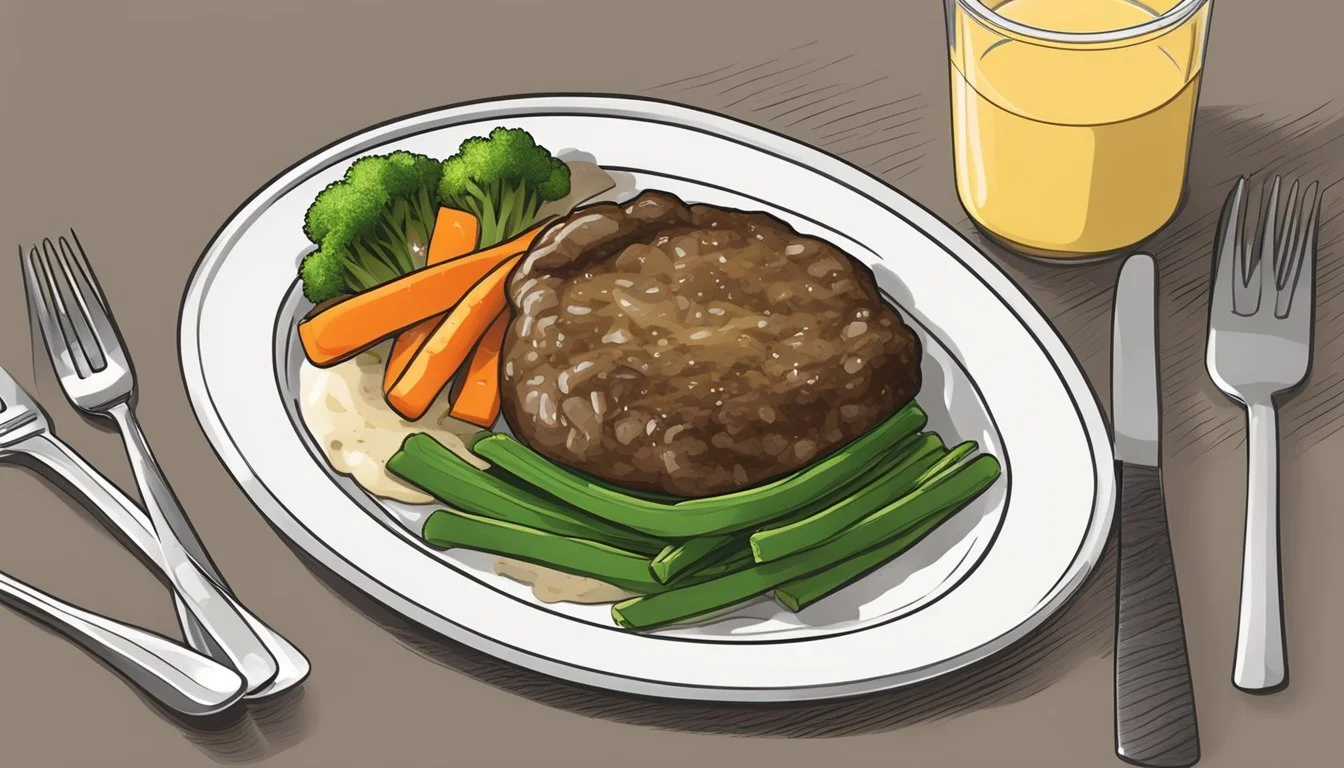How to Reheat Gluten-Free Salisbury Steak
Best Methods and Tips
Reheating gluten-free Salisbury steak can be a challenge if you're aiming to maintain its hearty flavor and tender texture. To ensure the steak stays juicy and the gravy remains thick and rich, reheat the gravy-covered steaks slowly on medium heat. This method preserves the delicious flavors without compromising the texture.
Another effective approach is to use the stovetop. Adding a splash of beef broth can help reintroduce moisture, enhancing the meal without diluting its savory taste. Letting the steak rest after microwaving allows the juices to redistribute, maintaining both its flavor and nutritional benefits.
These techniques are especially useful for those who follow a gluten-free diet. Ensuring your reheated Salisbury steak remains as tasty and satisfying as the day it was first prepared is easily achievable with these simple methods.
Understanding Gluten-Free Salisbury Steak
Gluten-free Salisbury steak offers a wholesome twist to the classic dish without compromising on taste. This section explores the fundamental components of Salisbury steak and the specific adjustments to make it gluten-free.
The Basics of Salisbury Steak
Salisbury steak is a savory dish made primarily from ground meat, often beef, and shaped into patties.
These patties are typically seasoned and may include ingredients like onions, eggs, and breadcrumbs.
Once shaped, the patties are cooked and served with a rich gravy, often containing mushrooms.
Key Characteristics:
Main Ingredient: Ground beef
Flavor: Savory and hearty
Preparation: Mix, shape, and cook
Salisbury steak is reminiscent of a burger patty but with a gravy that enhances its flavor. It's commonly paired with mashed potatoes, green beans, or other side dishes typically found in a hearty dinner.
What Makes It Gluten-Free
Making Salisbury steak gluten-free involves substituting traditional gluten-containing ingredients with alternatives.
Common Adjustments:
Breadcrumb Substitute: Use oats or gluten-free breadcrumbs instead of regular breadcrumbs.
Gravy Thickener: Use cornstarch or gluten-free flour instead of wheat flour.
Important Substitutes:
Oats: Acts as a binder for the meat patties
Cornstarch: Thickens the gravy without gluten
These substitutions ensure the dish remains safe for those with gluten sensitivities or celiac disease while preserving the dish's integrity.
By focusing on these key adjustments, one can achieve a gluten-free version of Salisbury steak that retains its traditional taste and texture.
Ingredients Breakdown
Reheating gluten-free Salisbury steak requires special attention to ingredients to retain flavor and texture. Focus on choosing the right meat, using gluten-free alternatives, enhancing flavors with seasonings, and making a gluten-free gravy.
Choosing the Right Meat
Ground beef is essential, ideally lean ground beef to reduce excess fat. Lean beef keeps the dish healthy and avoids greasy gravy. Some cooks prefer ground turkey for a lighter variant. Regardless of the meat, ensuring it’s fresh is crucial for the recipe's success.
Gluten-Free Binding Alternatives
Binding ingredients help hold the patties together. Eggs provide a natural binder. For a gluten-free version, replace traditional breadcrumbs with gluten-free breadcrumbs or gluten-free panko. These alternatives provide texture without gluten, ensuring the dish is safe for those with gluten intolerance.
Seasonings for Enhanced Flavor
Seasonings make or break the dish. Incorporate Worcestershire sauce for umami. Garlic powder and onion powder add depth. Salt and pepper are fundamental, enhancing the overall taste. Some recipes include Dijon mustard for a tangy kick.
Making Gluten-Free Gravy
The gravy is the star. A base of beef broth or beef stock gives it richness. To thicken the gravy, cornstarch can be a great gluten-free alternative to regular flour. For additional flavor, add sautéed mushrooms and onions. Season with salt and pepper, and simmer until thickened.
This approach ensures a delicious, gluten-free Salisbury steak with a hearty, satisfying taste.
Preparing the Patties
When preparing gluten-free Salisbury steak patties, it's crucial to focus on forming the patties properly and cooking them with precision. This ensures that they hold together well and attain the desired texture and flavor.
Forming the Perfect Patties
To create the patties, start with high-quality ground beef. Place the beef in a mixing bowl. Add an egg, which acts as a binder, and gluten-free breadcrumbs to help give the patties structure.
Season the mixture with salt, pepper, and other spices such as onion powder and garlic powder. Mix thoroughly but gently to avoid overworking the meat, which can make the patties tough.
Form the mixture into evenly sized patties. Making uniform patties ensures even cooking. Patties should be about one inch thick for the best results. Lay them on a tray lined with parchment paper until ready to cook.
Cooking Techniques
There are several methods to cook the patties effectively. One popular method is to sear them in a skillet. Heat a small amount of oil, like avocado or olive oil, in a non-stick skillet over medium-high heat.
Once hot, carefully add the patties and cook for 1-2 minutes per side until a golden-brown crust forms. This initial sear locks in juices and adds flavor.
After searing, reduce the heat to medium-low. Continue cooking for several more minutes on each side until fully cooked through. Use a meat thermometer to ensure the internal temperature reaches 160°F.
Alternatively, the patties can be cooked on a grill. Preheat the grill to medium heat and cook the patties for 3-4 minutes per side. Both methods deliver delicious results.
Cooking the Perfect Salisbury Steak
Achieving the ideal Salisbury steak involves two essential techniques: pan-searing the patties for a crisp crust and simmering them gently to ensure tenderness and juiciness.
Pan-Searing for a Crust
Pan-searing is crucial for creating a flavorful, crispy crust on the Salisbury steak. Begin by heating a skillet over medium-high heat with a small amount of oil, such as avocado or olive oil.
Place the formed beef patties into the hot oil and cook each side for about 1-2 minutes. This step locks in the juices and adds texture. Avoid overcrowding the pan, as this can reduce the heat and prevent proper searing.
Using a meat thermometer helps in monitoring the patties' internal temperature, ensuring they've reached a safe level before moving them for the next step. A properly seared crust gives the patties a mouthwatering flavor and keeps them juicy inside.
Simmering to Perfection
Simmering ensures the Salisbury steak patties remain tender and juicy. After searing, remove the patties from the skillet and set them aside temporarily. Reduce the heat to medium-low and add beef broth and other liquid ingredients to the skillet.
Reintroduce the seared patties, gently simmering them in the flavorful sauce. Cover the skillet and allow the patties to cook slowly for about 15-20 minutes. This method helps infuse the meat with rich flavors while maintaining its moisture.
A meat thermometer should read at least 160°F to confirm the patties are fully cooked. This process guarantees a tender, juicy inside while preserving the flavorful crust from the earlier searing.
Serving Suggestions
To truly enjoy gluten-free Salisbury steak, pairing it with the right side dishes and presenting it appealingly can make a significant difference. Let's explore some splendid sides and effective presentation tips.
Accompanying Side Dishes
Mashed potatoes are a classic choice and pair exceptionally well with Salisbury steak. For more indulgence, opt for creamy mashed potatoes.
Green beans and Brussels sprouts provide a fresh, vibrant counterpoint. Steam or sauté them for added flavor.
Rice is another excellent companion. Consider serving with seasoned rice or a wild rice blend for added texture.
Other popular sides include a simple salad, roasted vegetables, and gluten-free dinner rolls.
A savory gravy or sauce can tie everything together, enhancing both the steak and side dishes.
Presentation Tips
Visual appeal enhances the dining experience. Start by placing the Salisbury steak at the center of the plate.
Use a large spoon to create a bed of mashed potatoes or rice, then nestle the steak on top. Drizzle with gravy for added flavor and aesthetics.
Position vegetables like green beans or Brussels sprouts on the side in small bunches for a pop of color.
Garnish with fresh herbs like parsley or chives for a finishing touch. Use white plates to make the colors and textures stand out.
Ensure each plate is clean and free of smudges to maintain a neat appearance.
These details can elevate the meal, making it as pleasing to the eyes as it is to the palate.
Reheating Techniques
Reheating gluten-free Salisbury steak can be done effectively using either the microwave or oven methods. Both techniques aim to preserve the steak’s texture and flavor. Here is a detailed look at each method.
Microwave Method
When using the microwave, the key is to do it in short bursts to avoid overcooking. Start by placing the Salisbury steak on a microwave-safe plate. If available, add some gravy or a splash of beef broth to retain moisture.
Set the microwave to medium power. Heat for 2-3 minutes. Check for even heating, then flip the steak and stir the gravy. Heat for another 1-2 minutes, ensuring the internal temperature reaches 165°F.
After microwaving, let the steak rest for a minute. This allows the juices to redistribute, enhancing the taste and texture. Cover with a microwave-safe lid or wrap to keep it moist.
Oven-Based Approach
Preheat the oven to 350°F. Place the steak and gravy in an oven-safe dish. Ensure the gravy is sufficient to cover the bottom of the dish, adding some extra beef broth if needed.
Cover the dish with foil to prevent the steak from drying out. Reheat for 12-15 minutes. Check that the internal temperature is at least 165°F to ensure it is heated through.
For an even more tender result, allow the steak to rest in the oven for a few minutes after turning off the heat. This final step helps maintain the ideal texture and flavor.
Proper Storage Solutions
To ensure your gluten-free Salisbury steak retains its quality, proper storage is essential. For short-term freshness, refrigeration works best, while freezing is ideal for long-term use.
Storing for Short-Term Freshness
Refrigerate your cooked gluten-free Salisbury steak within two hours to maintain its taste and texture. Use airtight containers, as oxygen can degrade its quality. Place the steaks in shallow containers to cool faster and evenly distribute the cold air. Label the containers with the date, so you can keep track of freshness.
Optimal refrigeration temperature is below 40°F (4°C). This reduces the risk of bacterial growth. Consume refrigerated Salisbury steak within 3-4 days for the best flavor. If the gravy is separate, store it in a different container to prevent the steak from becoming soggy.
Freezing for Long-Term Use
For extended storage, freezing is the way to go. Allow the steak to cool completely before freezing to avoid ice crystals. Wrap each steak individually in plastic wrap or aluminum foil. This prevents freezer burn and preserves moisture.
Then, place the wrapped steaks in a freezer-safe bag or container, labeled with the date. Keep your freezer at 0°F (-18°C) or lower. Gluten-free Salisbury steaks can stay frozen for up to 2-3 months without significant quality loss.
When ready to eat, thaw the steaks in the refrigerator overnight. Avoid thawing at room temperature to prevent bacteria growth. Properly reheated frozen steaks will taste almost as good as fresh ones.
Recipe Variants and Dietary Adjustments
Various dietary adjustments can make gluten-free Salisbury steak suitable for different preferences and restrictions. Consider using meat substitutes and allergen-free ingredients to cater to various dietary needs.
Vegetarian and Other Meat Substitutes
For those who prefer not to eat meat, vegetarian options can be made using plant-based ground meat substitutes. These products are often available in supermarkets and can be used similarly to ground beef.
Mushrooms are another great substitute; they provide a meaty texture and umami flavor. Ground turkey or pork is also effective for those who prefer lighter or alternative meats.
A simple switch to ground turkey can lower the fat content. Combining these proteins with gluten-free breadcrumbs, spices, and egg can yield a delicious patty.
Incorporating Additional Allergen-Free Ingredients
Allergen-free adjustments help those with dietary restrictions enjoy Salisbury steak. Dairy-free options include substituting milk with almond or soy milk and using dairy-free butter for sautéing vegetables.
When preparing the gravy, use vegetable broth instead of beef broth for a vegetarian tilt. Ensure the Worcestershire sauce is gluten-free and soy-free by checking labels.
If avoiding soy, tamari is an excellent alternative. Adding xanthan gum instead of flour or cornstarch thickens the gravy without gluten. Using these adjustments ensures the meal remains both delicious and accessible.







